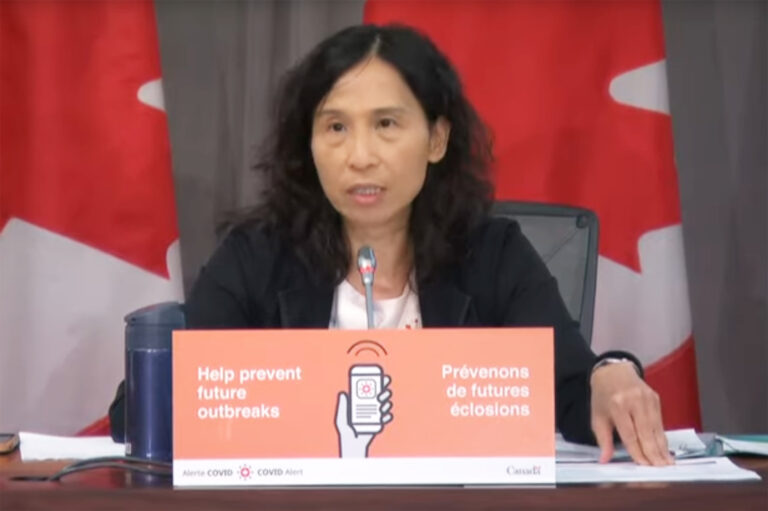
Federal health authorities estimate Canada could see more than 20,000 new COVID-19 cases per day by the end of December if efforts aren’t made to reduce the virus’ spread.
Canada currently has roughly 52,000 active cases to date, and more than 315,000 cases total since the start of the pandemic. An average of 4,800 new cases have been reported daily over the past week.
There are 48 health regions have infection rates of more than 50 cases per 100,000 residents, which is nine more than was reported three weeks ago.
Chief Medical Health Officer Dr. Theresa Tam said that’s a sign the virus is spreading quickly across a wide-geographic area. She urged Canadians to reduce their contacts to help reduce the stress on an over-worked healthcare system.
“Even right now, the healthcare system in certain jurisdictions—certain cities—is already feeling the pressure,” Tam told reporters during an update on Friday. “If that’s happening now, you can imagine that these exhausted healthcare workers are not going to be able to cope.”
Tam said Canada is “not on a good trajectory” and urged officials to put restrictions in place as soon as possible to help stop the spread.
She said today’s COVID numbers reflect policies that were in place up to two weeks ago, so the impact of recent efforts like Saskatchewan’s mandatory mask policy may not show up in the data.
Tam said the six non-Atlantic provinces are driving up Canada’s daily case count. All six reported record daily numbers over the past week. The percentage of positive COVID-19 tests results has also increased for several weeks.
Canada has reported an average of 4,800 new cases daily. That’s a 15 per cent increase over the week before. It’s also higher than peak levels seen during the first wave.
“The only way for Canada to stop the rapid growth of COVID-19 and keep our health, social and economic systems functioning is for individuals and public health authorities to work together,” Tam said. “This won’t be forever.”
Seniors and young adults were the two demographics hit hardest by the recent COVID spike. Reported incidents are consistently high among those ages 20-39, while cases among seniors over the age of 80 have increased for several weeks. Roughly one-third of all active cases are in Indigenous communities.
The percentage of COVID tests that come back positive has also steadily increased. After hovering around one per cent for most of the summer, it’s jumped to 6.5 per cent in November. Tam said that’s likely a sign provinces need to increase testing.
As of Friday, 11,334 Canadians have died from the virus, out of roughly 321,000 total cases. Short-term forecasts show the number of deaths rising to between 11,870 and 12,120 by the end of November if urgent action isn’t taken. The total number of COVID-19 cases could jump to between 366,500 and 378,600 during that same time.
Tam said the long and short-term forecasts are concerning, but she remained optimistic Canadians could reduce those numbers.
Prime Minister Justin Trudeau told Canadians they needed to do “everything they could” to stop the spread during an address to the nation in front of his home at 24 Sussex Drive.
Trudeau said it’s frustrating to see a second wave of COVID cases, but he urged residents to double down, follow public health orders, and reverse the trend.
“We must be realistic,” he said. “The only way to reduce this trend is to reduce the contacts we have with other people. If you don’t need to leave your home, then stay home…. Help us to break this second wave and save lives.”
“I know this isn’t what people wanted to see or hear, but we have to be realistic about the situation,” he added.
The government introduced a number of new measures to help fight COVID-19 on Friday. Among them were an immediate $120-million funding commitment to help Indigenous communities in Saskatchewan and Alberta. Trudeau said that money would go towards “surge capacity needs” like food security. He also extended the U.S. border closure until Dec. 21.
Trudeau pushed back on concerns that more COVID-19 restrictions would hurt business owners. He said new government benefits will cover up to 90 per cent of rent payments for businesses affected by COVID, and told Canadians the quickest way to save the economy was to get the virus under control.
